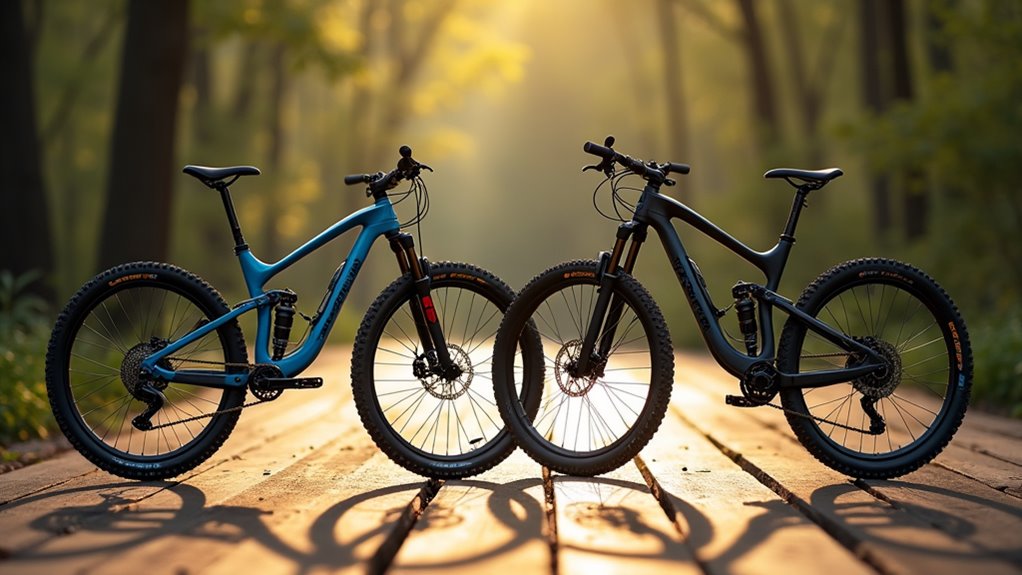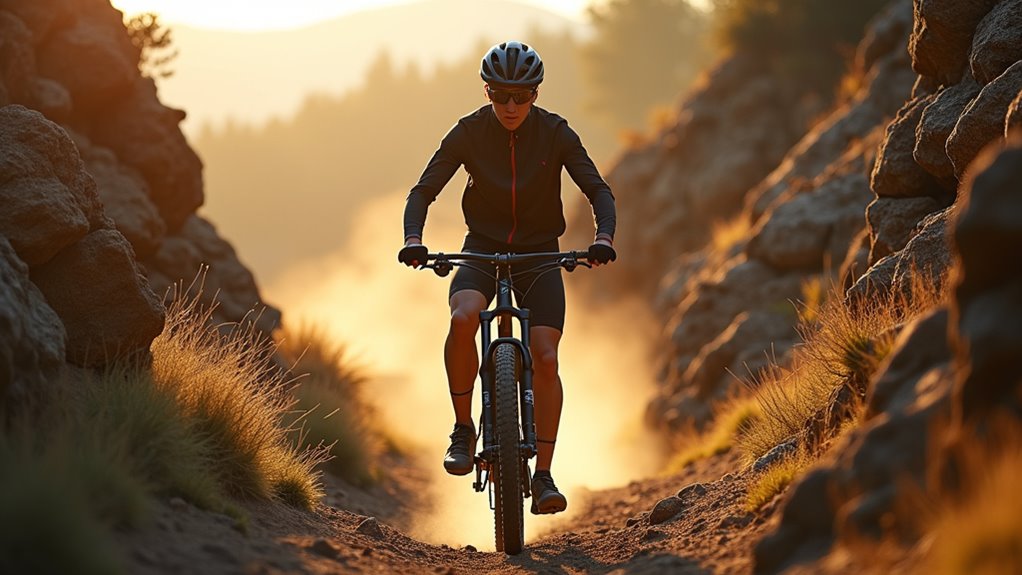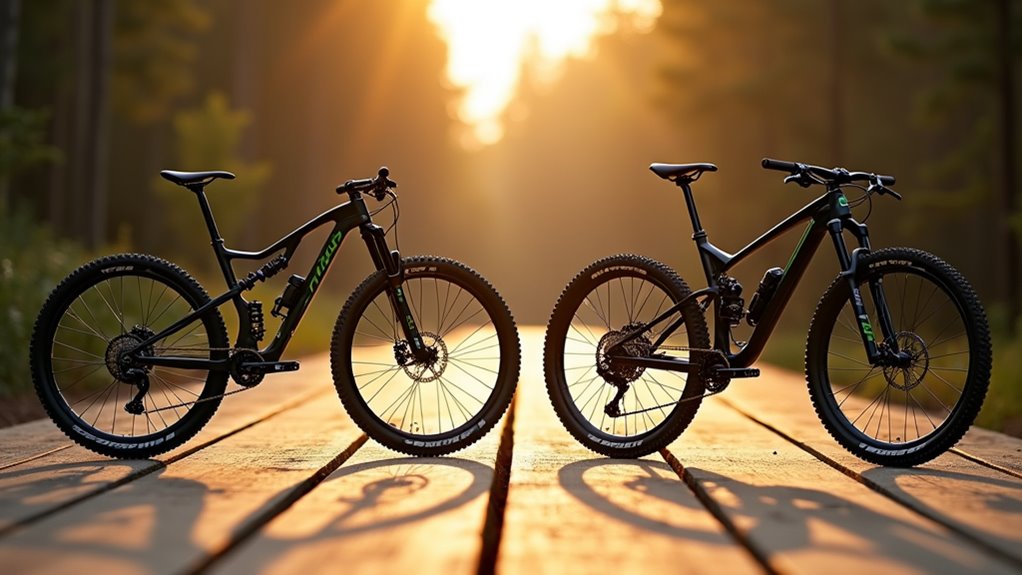Physical Address
304 North Cardinal St.
Dorchester Center, MA 02124
Physical Address
304 North Cardinal St.
Dorchester Center, MA 02124

Choosing between hardtail and full suspension bikes involves crucial factors that could completely transform your riding experience forever.
Choosing between a hardtail and full suspension mountain bike might just be the most essential decision you’ll make as a cyclist. You’re not just picking a bike—you’re shaping every ride for years to come. Your terrain, riding style, and wallet all play critical roles in this choice, but there’s more to consider than meets the eye. Before you spend your hard-earned cash, you’ll want to understand exactly how each option impacts your performance and budget.

When you’re shopping for your first mountain bike or looking to upgrade on a budget, hardtail bikes offer an excellent entry point into off-road cycling. These bikes feature front suspension only, with a rigid rear frame that eliminates the complexity and cost of rear shock systems.
You’ll find hardtails deliver efficient power transfer since there’s no rear suspension to absorb your pedaling energy. This makes them ideal for climbing and cross-country riding.
They’re also notably lighter than full-suspension bikes, making them easier to maneuver and carry.
Maintenance costs stay low because you’re dealing with fewer moving parts.
Most hardtails cost 30-50% less than comparable full-suspension models, letting you invest savings into better components like wheels or drivetrains for improved performance.
Many riders use their hardtails to explore world-class hiking trails that also accommodate mountain biking adventures.
While hardtails excel at efficiency and simplicity, full suspension bikes bring a different set of advantages that make them worth considering if your budget allows.
Full suspension bikes offer compelling advantages over hardtails, but only if your budget can accommodate the higher investment.
You’ll get rear shock absorption that smooths out rough terrain, reducing fatigue on longer rides. The extra traction from both wheels staying connected to the ground helps you climb technical sections more effectively.
Full suspension bikes shine on descents, giving you confidence to tackle steeper, rockier trails. However, they’re heavier and require more maintenance than hardtails.
You’ll also pay considerably more upfront – expect to spend at least $1,500 for entry-level quality.
Consider full suspension if you’re riding aggressive trails regularly, have joint concerns, or prioritize comfort over climbing efficiency. Just like choosing the right bike for your adventures, selecting the perfect travel backpack can make or break your biking trips to remote destinations.

Your trail choices should drive your bike decision more than flashy features or brand names. If you’re riding smooth singletrack, fire roads, or cross-country trails, a hardtail delivers efficient pedaling and costs less. You’ll appreciate the direct power transfer on climbs and won’t miss rear suspension on gentler terrain.
However, technical descents, rock gardens, and chunky trails demand full suspension. The rear shock absorbs hits that would otherwise bounce you around or slow you down.
If your local trails feature roots, drops, or aggressive terrain, you’ll ride faster and more confidently with both wheels cushioned.
Consider your typical riding: 80% smooth trails? Choose hardtail. Mostly technical terrain? Invest in full suspension. Match your bike to where you actually ride, not where you dream of riding.
Just as you’d plan your route and assess conditions before crossing a river, evaluate your local trail conditions thoroughly before committing to either bike type.
Budget realities often matter more than terrain preferences when choosing between hardtail and full suspension bikes. You’ll typically pay 30-50% more for full suspension models, with entry-level options starting around $2,000 compared to quality hardtails at $800-1,200.
Budget constraints drive bike choice more than trail preferences, with full suspension costing 30-50% more than comparable hardtails.
Consider these long-term costs:
However, you’ll save money on body wear and gear replacements with full suspension’s comfort advantages.
Calculate your riding frequency and maintenance budget carefully. If you’re weekend-only riding or cost-conscious, hardtails deliver excellent value and performance longevity.

Beyond budget considerations, your specific riding discipline should drive your hardtail versus full suspension decision. If you’re primarily hitting cross-country trails or racing, hardtails deliver superior pedaling efficiency and lighter weight that’ll help you climb faster while saving money.
For aggressive trail riding, enduro, or downhill mountain biking, full suspension becomes essential—you’ll need that rear shock to handle big drops and technical terrain safely.
Commuting and casual riding? A hardtail’s simplicity and lower maintenance costs make more sense. However, if you’re tackling varied terrain regularly or plan to progress into more challenging rides, investing in full suspension now prevents you from outgrowing your bike quickly.
Match your bike choice to where you’ll spend 80% of your riding time, not that occasional epic adventure. Remember that even the best-laid plans can go awry, so knowing how to handle camping mishaps will serve you well during multi-day bikepacking adventures.
While performance differences grab attention, maintenance demands often determine long-term satisfaction with your bike choice. Hardtails win the simplicity game with fewer moving parts to service and replace. You’ll spend less time and money keeping them running smoothly.
Fewer moving parts mean hardtails deliver straightforward maintenance and lower long-term costs than complex full suspension systems.
Full suspension bikes require more attention and deeper pockets:
Your wallet will appreciate hardtail ownership. Basic maintenance involves standard drivetrain care, brake adjustments, and occasional wheel truing.
Full suspension demands specialized tools and knowledge for proper shock maintenance. If you’re budget-conscious or prefer straightforward upkeep, hardtails offer reliable performance without the complexity.
However, don’t let maintenance concerns completely deter you if full suspension matches your riding needs. Learning from common maintenance mistakes can help you avoid costly repairs and extend your bike’s lifespan regardless of which suspension type you choose.
Like choosing between a reliable sedan and a luxury SUV, you’re weighing practicality against performance. If you’re counting pennies and stick to smooth paths, the hardtail’s your trusty companion—simple, efficient, and won’t drain your wallet. But if you’ve got cash to burn and crave those gnarly descents, full suspension’s your ticket to comfort. Don’t overthink it—match your terrain, budget, and riding ambitions. The right bike’s the one you’ll actually ride consistently.